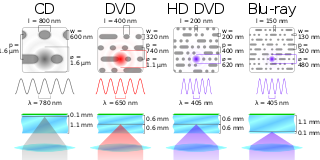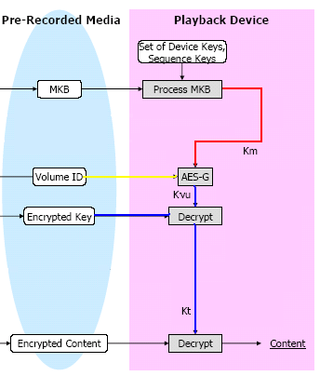Related Research Articles
A DVD player is a machine that plays DVDs produced under both the DVD-Video and DVD-Audio technical standards, two different and incompatible standards. Some DVD players will also play audio CDs. DVD players are connected to a television to watch the DVD content, which could be a movie, a recorded TV show, or other content.

The Blu-ray Disc Association (BDA) is the industry consortium that develops and licenses Blu-ray technology and is responsible for establishing format standards and promoting business opportunities for Blu-ray Disc. The BDA is divided into three levels of membership: the board of directors, contributors, and general members.
AnyDVD is a device driver for Microsoft Windows which allows decryption of DVDs on the fly, as well as targeted removal of copy preventions and user operation prohibitions (UOPs). With an upgrade, it will also do the same for HD DVD and Blu-ray Disc. The AnyDVD program runs in the background, making discs unrestricted and region-free. In addition to removing digital restrictions, AnyDVD will also defeat Macrovision analog copy prevention. Analog prevention distorts the video signal to prevent high quality copying from the output. AnyDVD is also able to remove copy-prevention from audio CDs.

RedFox is a software development company based in Belize. The company is most prominently known for its software AnyDVD, which can be used to bypass copy protection measures on optical media, including DVD and Blu-ray Disc media, as well as CloneCD, which is used to back up the contents of optical discs.

BackupHDDVD is a small computer software utility program available in command line and GUI versions which aids in the decryption of commercial HD DVD discs protected by the Advanced Access Content System. It is used to back up discs, often to enable playback on hardware configurations without full support for HDCP. The program's source code was posted online, but no licence information was given.

This article compares the technical specifications of multiple high-definition formats, including HD DVD and Blu-ray Disc; two mutually incompatible, high-definition optical disc formats that, beginning in 2006, attempted to improve upon and eventually replace the DVD standard. The two formats remained in a format war until February 19, 2008, when Toshiba, HD DVD's creator, announced plans to cease development, manufacturing and marketing of HD DVD players and recorders.

The Advanced Access Content System (AACS) is a standard for content distribution and digital rights management, intended to restrict access to and copying of the post-DVD generation of optical discs. The specification was publicly released in April 2005. The standard has been adopted as the access restriction scheme for HD DVD and Blu-ray Disc (BD). It is developed by AACS Licensing Administrator, LLC, a consortium that includes Disney, Intel, Microsoft, Panasonic, Warner Bros., IBM, Toshiba and Sony. AACS has been operating under an "interim agreement" since the final specification has not yet been finalized.

The DVD is a digital optical disc data storage format. It was invented and developed in 1995 and first released on November 1, 1996, in Japan. The medium can store any kind of digital data and has been widely used to store video programs, software and other computer files. DVDs offer significantly higher storage capacity than compact discs (CD) while having the same dimensions. A standard single-layer DVD can store up to 4.7 GB of data, a dual-layer DVD up to 8.5 GB. Variants can store up to a maximum of 17.08 GB.

Blu-ray is a digital optical disc data storage format designed to supersede the DVD format. It was invented and developed in 2005 and released worldwide on June 20, 2006, capable of storing several hours of high-definition video. The main application of Blu-ray is as a medium for video material such as feature films and for the physical distribution of video games for the PlayStation 3, PlayStation 4, PlayStation 5, Xbox One, and Xbox Series X. The name refers to the blue laser used to read the disc, which allows information to be stored at a greater density than is possible with the longer-wavelength red laser used for DVDs, resulting in an increased capacity.

HD DVD is an obsolete high-density optical disc format for storing data and playback of high-definition video. Supported principally by Toshiba, HD DVD was envisioned to be the successor to the standard DVD format, but lost out to Blu-ray, which was supported by Sony and others.
BD+ is a component of the Blu-ray Disc digital rights management system. It was developed by Cryptography Research Inc. and is based on their Self-Protecting Digital Content concept. Its intent was to prevent unauthorized copies of Blu-ray discs and the playback of Blu-ray media using unauthorized devices.

The security of Advanced Access Content System (AACS) has been a subject of discussion amongst security researchers, high definition video enthusiasts, and consumers at large since its inception. A successor to Content Scramble System (CSS), the digital rights management mechanism used by commercial DVDs, AACS was intended to improve upon the design of CSS by addressing flaws which had led to the total circumvention of CSS in 1999. The AACS system relies on a subset difference tree combined with a certificate revocation mechanism to ensure the security of high definition video content in the event of a compromise.
China Blue High-Definition is a high definition optical disc format announced in September 2007 by the Optical Memory National Engineering Research Center (OMNERC) of Tsinghua University in China.
Advanced Content provides interactivity in the HD DVD optical disc format.

The high-definition optical disc format war was a market competition between the Blu-ray and HD DVD optical disc standards for storing high-definition video and audio; it took place between 2006 and 2008 and was won by Blu-ray Disc.
The Content Scramble System (CSS) is a digital rights management (DRM) and encryption system employed on many commercially produced DVD-Video discs. CSS utilizes a proprietary 40-bit stream cipher algorithm. The system was introduced around 1996 and was first compromised in 1999.

DVD-Video is a consumer video format used to store digital video on DVDs. DVD-Video was the dominant consumer home video format in Asia, North America, Europe, and Australia in the 2000s until it was supplanted by the high-definition Blu-ray Disc; both receive competition as delivery methods by streaming services such as Netflix and Disney+. Discs using the DVD-Video specification require a DVD drive and an MPEG-2 decoder. Commercial DVD movies are encoded using a combination of MPEG-2 compressed video and audio of varying formats. Typically, the data rate for DVD movies ranges from 3 to 9.5 Mbit/s, and the bit rate is usually adaptive. DVD-Video was first available in Japan on October 19, 1996, followed by a release in March 24, 1997, in the United States.

The Media Key Block (MKB) is one of the keys included inside the copying protection system (DRM) AACS. This system is used to prevent Blu-ray and HD DVD formats from being copied. The system was developed by companies from the film industry and the electronics industry including IBM, Intel, Microsoft, Matsushita (Panasonic), Sony, Toshiba, The Walt Disney Company and Warner Bros.

A controversy surrounding the AACS cryptographic key arose in April 2007 when the Motion Picture Association of America and the Advanced Access Content System Licensing Administrator, LLC began issuing cease and desist letters to websites publishing a 128-bit (16-byte) number, represented in hexadecimal as 09 F9 11 02 9D 74 E3 5B D8 41 56 C5 63 56 88 C0, a cryptographic key for HD DVDs and Blu-ray Discs. The letters demanded the immediate removal of the key and any links to it, citing the anti-circumvention provisions of the United States Digital Millennium Copyright Act (DMCA).

Cinavia, originally called Verance Copy Management System for Audiovisual Content (VCMS/AV), is an analog watermarking and steganography system under development by Verance since 1999, and released in 2010. In conjunction with the existing Advanced Access Content System (AACS) digital rights management (DRM) inclusion of Cinavia watermarking detection support became mandatory for all consumer Blu-ray Disc players from 2012.
References
- ↑ Dean, Katie (15 July 2004). "Can Odd Alliance Beat Pirates?". Wired. Retrieved 11 March 2023.
- ↑ Martyn Williams (14 December 2005). "Toshiba Hints at HD-DVD Delay". pcworld.com. Archived from the original on 5 October 2007. Retrieved 19 October 2007.
- ↑ Craig Morris (14 February 2006). "AACS copy protection for Blu-ray disc and HD DVD delayed again". heise.de. Archived from the original on 2 November 2007. Retrieved 19 October 2007.
- ↑ Perenson, Melissa J. (21 March 2006). "Burning Questions: No Copying From First High-Def Players". PC World. Archived from the original on 19 December 2006. Retrieved 25 October 2006.
- ↑ Calonge, Juan (8 June 2009). "AACS Final License Goes Online". blu-ray.com. Retrieved 11 March 2023.